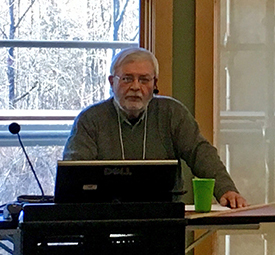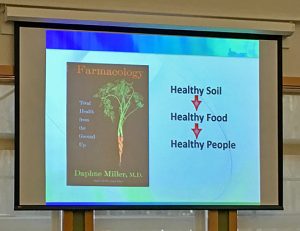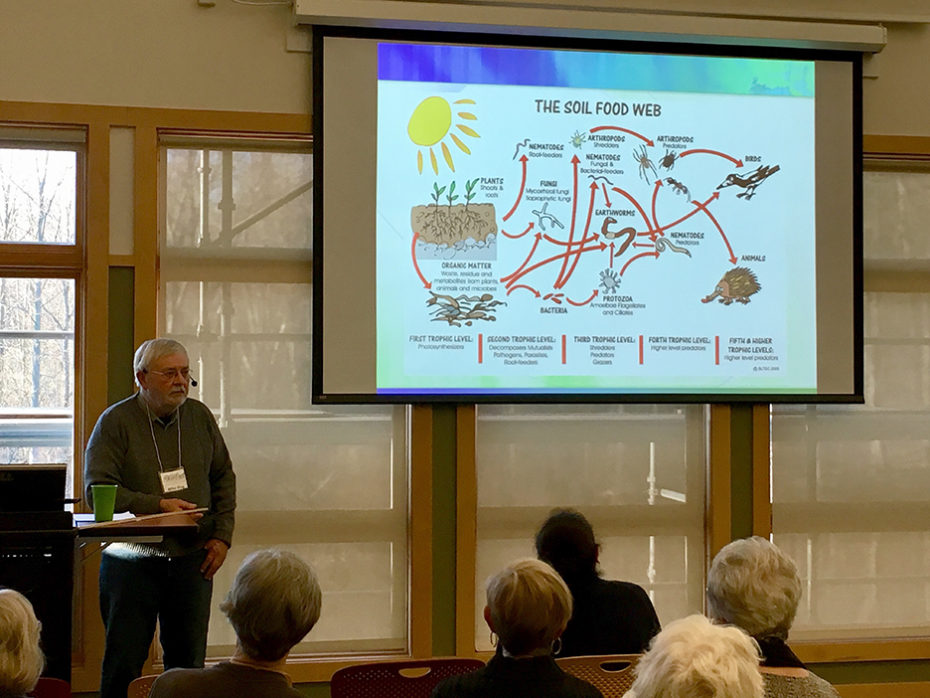“Sustaining Soil Communities” a presentation by Mike Klug
Wild Ones River City Chapter – Monday, April 15, 2019
Written by Nancy Bedell
 Mike was employed by Michigan State University at the W. K. Kellogg Biological Station between Kalamazoo and Battle Creek for his entire career. As a result, he has studied soil because he worked right with it.
Mike was employed by Michigan State University at the W. K. Kellogg Biological Station between Kalamazoo and Battle Creek for his entire career. As a result, he has studied soil because he worked right with it.
He reports that soil degradation begins 10,000 years ago already, with arability and fertility affected. Humans don’t notice the changes because we can’t see them. Soil stores a lot of carbon already and could store more to help reduce climate change. We also probably don’t know that one-quarter of the world’s biodiversity lives in the world’s soil.
We have heard of “Peak Oil”. That is the theory that after a certain time the commodity is in decline. Mike reports that soil peaked in the year 2000. Soil fertility is like a bank account. If we keep taking nutrients from the soil and don’t put nutrients back in, we reduce its ability to support our food system. 33 % of our soil is degraded and 83% suffers from erosion, compaction, acidification or chemical pollution. In Africa where people live off the land, there is now little opportunity for expansion. All of the arable land is in use. Because of the soil situation food costs are rising and there is essentially no longer any “cheap food.”
Currently, there are 3.5 acres per person of arable land in the world. In 2050 there will only be less than an acre per person due to population growth and the soil’s depletion.
 We must sustain the microbes for healthy, fertile soil. Mike recommends the book Farmacology, written by a physician and nutrition explorer Daphne Miller, M.D., who visited seven farms and reports on how soil can be sustained successfully with benefits to the food we eat.
We must sustain the microbes for healthy, fertile soil. Mike recommends the book Farmacology, written by a physician and nutrition explorer Daphne Miller, M.D., who visited seven farms and reports on how soil can be sustained successfully with benefits to the food we eat.
Mike divides the soil into its components and compares them to financial instruments. Fresh organic resident in the soil is 10% which would be “ready cash”. 33% – 50% of soil should be decomposing, like short term CDs in your financial portfolio. And 33% is hummus, the 401K of your finances: don’t touch it. It’s necessary for sustainable soil.
The difference between soil and “dirt” is that soil has structure and complexity It has some organic matter. This is being reduced by the use of inorganic fertilizers. The structure allows water retention and carbon storage (sequestration). It allows for a slow release of nutrients. The major biological activity takes place in the top soil layers.
What problems does Soil have today?
Organic matter is not being replaced. Crop diversity has been reduced, with little crop rotation. There are many more annual crops grown. Soil erosion sends soil into the water system. 60,000 km of soil is lost annually from wind and water erosion alone. The latter is exasperated by the addition of inorganic fertilizer and soil warming due to climate change. Corn, which is primarily grown for silage, depletes the soil, so little organic residue is left.
Sustainable soil management was begun in the 1980s. There are now new procedures for precision-based farming adding nutrients to the soil as needed after using drones to assess soil from above. Carbon banks are being established to offset the carbon released by plants. Soilless systems are growing, like hydroponics, however they cannot produce protein food by this method. Cover crops are in wider use leaving organic residues. Drip irrigation reduces water overuse and prevents erosion.
Perennial wheat could be a game changer as it would provide permanent soil cover, cutting down erosion and the wheat chaff would add organic matter back into the soil. We will see how the General Mills pilot program goes. If it works for General Mills is may come into prominence in the fields.
What can we all do to sustain our soil?
- Keep surface soil vegetated, that is, don’t leave soil unplanted for long. Use a cover crop if needed until planting.
- Increase organic content in the soil. Leave the leaves and organic matter. Add compost for the water holding capacity and to reuse organic debris.
- Don’t over till your soil. Only disturb the soil for individual plants you install.
- Avoid pesticide and herbicide use.
- Plant native plants to increase biodiversity. (Wild Ones’ mantra!)
- Buy local food, to cut out middle infrastructure which takes most of the profit, leaving the farmer too little gain.
Remember what President Franklin Delano Roosevelt said during the Dust Bowl years in the US during the 1930s:
“A country that destroys its soils destroys itself.”

